|
SpaceTides
Newsletter #32 - June 2005
Internet
Newsletter of ASSA Bloemfontein Centre,
South Africa, to the public
www.assabfn.co.za/spacetides
|
In this issue of SpaceTides
|
INDEX
1. Spaceflight news from around the world
2. Astronomy news from around the world
3. Interesting space facts
4. Space questions
5. Sky Observation log
6. Astronomy news in Southern Africa
7. Astronomy events in the City of Bloemfontein
8. Web links & Net nodes
Dear SpaceTides subscribers
Winter is upon us here in the central
region of South Africa.
Much reason to smile for night sky enthusiasts: clear dry, crisp skies dotted with stars! Do yourself a favour
and try to get outside the city one clear evening and take in the sight of the incredible Milky Way.
This week's
issue will focus on the important DEEP IMPACT mission to occur
on July 4, 2005. See section 1 below.
People frequently ask which astronomy books they should buy. It
is a good idea to own at least one good book on
astronomy. Believe me: most flashy astronomy books say exactly the same
thing, just in another way! Invest in one
which seems comprehensive (covering many aspects of astronomy) and which
has good, detailed sky maps in.
Also visit your local library and see what they have to offer. The only
way to become accustomed to astronomy is
to put in some effort into reading and going outside in the evenings and
observe the constellations and stars!
You can also visit astronomy websites like www.seasky.org/cosmic/sky7a.html or www.solarviews.com/eng/homepage.htm
for a good overview.
Gerrit Penning
Editor
Total subscribers as at 9 June 2005: 137 (+19 from previous
issue)
|
1. Spaceflight news from around the world
|
Spaceflight
in short:
The first ever mission to study the interior of a comet is about to
reach its climax when Deep Impact will launch
an impactor into Comet Tempel 1 on 4 July 2005. The collision might
even be visible through some medium-sized
telescopes on Earth!
|
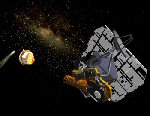 Image credt: NASA/JPL
Image credt: NASA/JPL
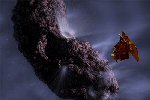 Image credit: NASA/JPL/UMD Artwork by Pat Rawlings
Image credit: NASA/JPL/UMD Artwork by Pat Rawlings
|
The Deep Impact mission to Comet Tempel 1
Adapted from the JPL Deep Impact Fact sheet: http://deepimpact.jpl.nasa.gov/mission/index.html
On July 4, NASA's Deep Impact satellite will launch a smaller impactor-craft
which will "collide" with comet Temple
1. Comets (large rocks orbiting the Sun) are "time capsules"
of the solar system: they contain age-old ice particles, gas and
dust which can tell us more about the formation of the solar system
some 4.5 billion years ago. Deep Impact will be the first
mission to probe beneath the surface of a comet and study its interior.
The crater that will be produced after impact will
vary between the size of a house and a rugby field, 2 to 14 stories
deep. The expectation is that ice and dust will be ejected into
space during impact, revealing "fresh" material beneath.
Cameras and spectrometers on the fly-by satellite and instruments
on Earth will closely monitor the complete collision procedure.
Data accumulated from these different sources might help us to gain
a better understanding of the formation of the solar system and
the implications that comet collisions had with Earth in the past.
Videos and animations: http://deepimpact.jpl.nasa.gov/gallery/animation.html
|
|
2. Astronomy news from around the world
|
Astronomy
in short:
- A Hubble picture of N 63A has been released: a huge gas cloud showing
the remnants of an exploded star in the
Large Magellanic Cloud 160 000 million light years away.
- The Spitzer Space Telescope captured
the surprising infrared "echo" of a neutron star which sent
blast waves
from inside the supernova remnant "Cassiopeia A".
|
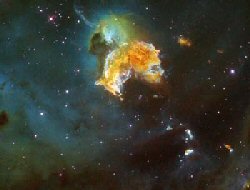 Image
credit: NASA, ESA, HEIC, (STScI/AURA) Image
credit: NASA, ESA, HEIC, (STScI/AURA)
|
Spectacular Hubble image of supernova remnant N
63A
07-06-2005,
larger image, with more info: http://hubblesite.org/newscenter/newsdesk/archive/releases/2005/15/
The
Hubble Space Telescope captured this stunning picture of a "violent
and chaotic-looking mass of gas and dust" of a nearby supernova
remnant. It was named N 63A and represents the remains of a massive
star that exploded and spewed its gaseous layers out into space.
The gas cloud
is situated in the Large Magellanic Cloud - a satellite galaxy of
our own Milky Way galaxy, 160 000 light years away. Scientists estimate
that the exploded star was 50 times more massive than our own star,
the Sun. Radio emission images of N 63A show a much more expanded
bubble that totally encompasses the optical emission seen by Hubble
here.
|
|
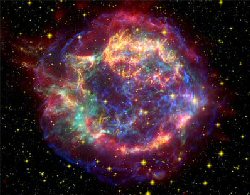 Image
credit:
NASA/JPL-Caltech/O. Krause (Steward Observatory) Image
credit:
NASA/JPL-Caltech/O. Krause (Steward Observatory)
|
Spitzer Space Telescope observes echo of neutron
star outburst
University of Arizona
News Release, June 9, 2005.
More
info and larger image: http://www.jpl.nasa.gov/news/news.cfm?release=2005-099
The
Spitzer telescope observed a huge light echo in infrared, produced
by a fitful dead star. This finding indicates that Cassiopeia A,
the remnant of a star that died in a supernova explosion 325 years
ago, is not resting peacefully. It is presumed that the star most
likely shot out at least one burst of energy as recently as 50 years
ago.
Scientists thought
that the star's remains were simply fading away, but this image
showed that it is still undergoing "death throes".
What you see here is clumps of the surrounding dust created by the
blast, heated by light waves moving outward and causing the dust
to glow in infrared.
|
|
3. Interesting Space Facts
|
|
- NASA's Chandra X-ray Observatory, which was launched
in 1999, is the most sophisticated X-ray observatory built to date.
The craft orbits around 130 000 km above Earth (about a third of
the distance to the moon). The
light from some of the objects Chandra can observe has been traveling
through space for over 14 billion years. Chandra homepage (with
e-mail news subscription service): http://chandra.harvard.edu/
|
|
- If the Earth was the size of the ball of
a ball-point pen (not even a millimeter in diameter), the Sun
would almost be the size of a golf ball and will have
to be placed 5 meters away for the distance scale to be more accurate.
Nearly 110 Earths can fit into the diameter of the Sun. More scale
facts: http://www.lpi.usra.edu/education/explore/solar_system/planet_sizes.shtml
|
|
-
Humans have only been physically as far as the moon. Mankind has
however, sent many robotic satellites,
landers or rovers to all the other solar system planets except
Pluto. Some has only flew by the planets, others were put into orbit
around them. Currently doing active planetary research work:
3 satellites orbiting Mars, two rovers traversing Mars, 1 satellite
orbiting Saturn and its moons and hundreds of satellites around
that very special of all planets, Earth! Other current missions,
e.g. Moon, Sun and more:
http://www.ccastronomy.org/space_missions_current.htm#Cluster%202
|
|

|
Why
do meteors ("shooting stars") emit such a huge amount
of energy when entering the atmosphere, even though...
...these
meteoroids are usually nothing else and nothing bigger than a grain
of sand?
We've
all seen those most beautiful of light streaks in the night sky,
popularly known as "shooting stars". On a daily basis,
as many as 4 billion meteors fall to Earth weighing in total several
tons. But why so bright? The answer: their enormous speed - meteors
travel at about 60 to 70 km a SECOND! (The Shuttle orbits Earth
at 8 km/s). "Ram pressure"
is also at work. Air is compressed by the meteor in front of it,
which heats up the air. The rock/grain of sand is heated in turn
and start to "burn up".
|
|
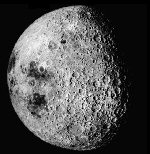 The
far side of the moon Credit: NASA / Apollo 16. The
far side of the moon Credit: NASA / Apollo 16.
|
Why does the same side of the Moon always faces
Earth?
Each
time you look at the Moon, whether in the day or at night, you will
always see the same side. Ever wondered why? This is because of
the way in which the Moon orbits the Earth. Where the Earth makes
one rotation every 24 hours around its own axis, it takes the moon
28 days to make one orbit around its own axis. This is also
"co-incidentally" the time that the moon takes to make
one orbit around the Earth. Ask a friend to play the Earth.
You are the Moon: walk around the person while facing him/her the
whole time. After you made "one orbit" around the person,
you would also have spun 360 degrees; as if you were stationary
while making the spin!
|
|
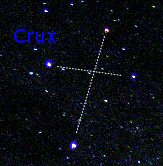
|
The
Southern Night Sky
South Africans should feel very fortunate to have at their disposal
such a magnificent view of the southern night sky. Especially in
Autumn and Winter, the constellations in the southern region are
bright and prominent, with a treasure trove of deep sky objects
(for binoculars and telescopes). The most beautiful region south
is probably the Centaurus-Crux area, and more to the west no doubt
the constellations of Argo: Carina, Vela, Puppis & Pyxis.
More information on how to begin observing the night sky:
www.assabfn.co.za/deepsky.htm
|
|
6. Astronomy News in Southern Africa
|
|
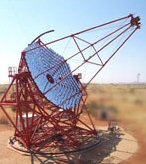
Credit: HESS
|
International H.E.S.S. project in Namibia
Information obtained from: www.unam.na/research/hess/
The
newly installed telescope, first of a series of many such instruments,
will be used to study space phenomena such as black holes, quasars,
pulsars, supernova remnants, exotic heavy particles left over from
the creation of the universe, etc. The site for the project is located
in the Khomas Highland, about 103 km West South West of Windhoek
on the farm Goelschau. H.E.S.S. stands for High Energy Stereoscopic
System. This acronym also honours the famous Austrian Physicist,
Victor F. Hess who discovered cosmic radiation in 1911/2. The project
is a major boost for Southern Africa's astronomical basis, adding
to its international reputation as an excellent observing region.
|
For other SA Astronomy
websites, go to the SpaceTides SA Astronomy Portal at:
www.assabfn.co.za/spacetides/sa_astronomy.htm
|
7. Astronomy Events in the City of Bloemfontein
|
|
The different astronomy organizations in the City,
working hand-in-hand to expose people to the interesting
world of astronomy and spaceflight, can be reached at the following
addresses:
|
|
Explore Boyden Observatory: www.assabfn.co.za/friendsofboyden/explore.htm
One
of the most publicly accessible observatories of its kind in the
Southern Hemisphere, also housing SA's third
largest telescope.
- Kunstefees lesing "En daar was lig", 13 Julie 2005
(CR Swart Ouditorium, UV kampus, 18:00) en 15 Julie 2005
(Boyden Sterrewag, 18:30 vir 19:00). Kaartjiebespreking verpligtend:
www.volksbladfees.co.za
|
|
The Friends of Boyden: www.assabfn.co.za/friendsofboyden
A public interest group for Boyden Observatory and for people interested
in joining the astronomy community of
Bloemfontein, but not make astronomy their "full-time"
hobby.
- Go to the Friends' website above for the calendar of 2005.
|
|
ASSA Bloemfontein Centre: www.assabfn.co.za
Affiliated
with the Astronomical Society of Southern Africa, the Bloemfontein
Centre of ASSA is an active organization of amateur astronomers
meeting on a regular basis to discuss and practise astronomy.
- Send an e-mail to mail@assabfn.co.za
for more information or visit the website.
|
|
Onthou
ook om Boyden Sterrewag se gereelde sterrekunde berigte in die "Ons
Stad" plaaslike koerant te lees.
Dit bevat ook meer inligting rondom Boyden besoektye.
|
- Final Frontier The Ultimate Space Wallpapers:
A collection of some of the best space wallpapers, categorized
in a convenient way: www.finalfrontier.za.org
- Deep Impact: An interesting, explanatory article about the Deep
Impact comet-crash mission:
www.celestron.com/astrowatch/view_article.php?ArticleID=10.
Thanks for the link Hannes!
- CNN space video vault: Find space videos, on the CNN website:
www.cnn.com/video_vault/space.html
- PlanetScapes - general space knowledge: a portal to the famous
Solar Views website at NASA: www.planetscapes.com
- Space-Graphics.com: spectacular computer rendered space images
of solar system bodies. A must-see!
www.space-graphics.com
- Other links/news on the web:
|
- e-Books which can be downloaded for free: www.gutenberg.org. These books are mostly
older literary works that are in the public domain in the United
States.
|
|
- Ever heard of the GO Open Source project? It is
sponsored by such organizations as The Shuttleworth Foundation
and the CSIR and can be reached at www.go-opensource.org.
It encourages distribution of their excellent low-cost or
free software.
|
|
- Coding theory used in cell phone technology and even
deep-space probes are to be used by HP as a new way of designing
nanoelectronic circuits, potentially decreasing manufacturing
costs extensively: Information
week website.
|
|
- Some say space is the final frontier, but in my opinion
it is the human brain! "Caring for your brain"
is probably just as important than caring for your body overall.
The New Scientist indicates 11 steps to a better brain: www.newscientist.com/channel/being-human/mg18625011.900
|
|
- Anyone got a Ph.D in robotics lately? Robots are
progressively being displaced out of sci-fi books and into reality.
Comprehensive info: www.learnaboutrobots.com
|
|
-
For those few spare minutes you don't know what constructive way
you can help society in, try a few puzzles!
www.puzzles.com
|
SpaceTides is a free internet e-zine for persons interested in expanding their
general knowledge of astronomy and spaceflight.
The e-zine originates from the City of Bloemfontein in South Africa and
is compiled us a service to the public by ASSA Bloemfontein Centre
as part of their educational outreach activities. Website: www.assabfn.co.za.
SpaceTides contains links to various other third party sites on the
internet, not always connected to SpaceTides. The persons and entities
responsible
for compiling SpaceTides will not be held responsible for the content
or information on these third party sites or any damage of any kind
incurred from
downloading, opening, or viewing anything from/through these sites.
If you would like to unsubscribe from SpaceTides, send an e-mail
to spacetides@assabfn.co.za with the word
"Unsubscribe" in the subject line.
|



